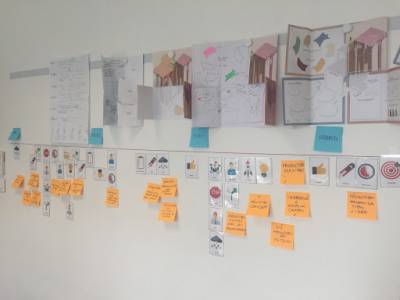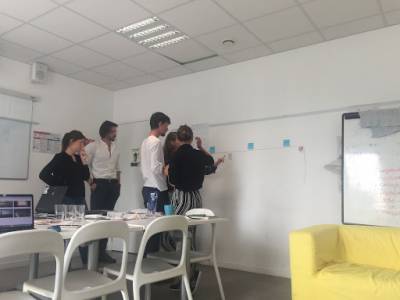Ceci est une ancienne révision du document !
Creative tools workshop
Organised by the L'Ecole de design City design Lab over a week, the tools workshop gathered different groups of students to conceive, produce, test and improve two specific AYCH tools to be used at AYCH events with young participants.
The tool creation process was research-driven and iterative. Through the creation process, the students gained a good understanding of the AYCH programme, the participants and the particularities of the events were the tools would be used. An important empathy work was the basis for conceiving or improving the tools. Constant communication with the AYCH partners allowed the students to get critical feedback as they tested the different versions of the tools.
As two groups of students worked on the creation of their respective tool, a third group of students observed the creative process and facilitated, at the end of the week, a feedback session for which they put in place a management communication tool. Thanks to the observation process and the final feedback session, the tool creators had the opportunity to analyse their creative process and have a critical stand on the challenges and opportunities of it.
Stranger Job
Stranger Job is a speculative design tool created by the City design lab students Benjamin Garnier, Louise Bragard, Jules Riché, Marguerite Gueret and Maurine Guingamp. The tool, in the form of a serious game, aims at fostering participant's creativity by setting the game into a near-future. The participants are then free to imagine the future as they would like it or not to be. They will then have to create the job(s) of the future.
The creative process
Feedback from the field
The tool was tested during the
Carte probleme Creer une enterprise
A journey to your project
A journey to your project, created by Marine Bauduin, Antoine Laurent and Chloé Verron; is a creative tool conceived to be used in one workshop of the Exmouth Creative Jam that took place in October 2019. The tool aims at helping a group of young participants to identify and quickly develop an idea that they will prototype later on. The tool takes the shape of a simple folding paper sheet that proposes different steps to go through collectively. The tool provides with a frame to follow a design thinking approach to help the participants to prototype more efficiently and easily.
The creative process
- During the creative process, exchanges with the Exmouth organisers prooved to be essential. At the beginning of the process, the needs of the partner, the aim of the workshop and the time allocated to using the tool weren't completely clear. In this sense, the group of students first created a version of the tool that was meant to be used individually. The aim was for each participant to develop their own idea and at the end of the session, the group would have to choose one idea to be prototyped during the whole creative jam. After a key feedback session with the partners, the tool went through some important adjustments. Rather than being an individual tool, the new version draws on the collective intelligence of the participants to develop one single idea and more focus was put into identifying the best prototyping technique for that idea.
 * In the image, we can see the evolution of the creative process, the difficulties the group encounter through it and the different forms the tool took as the creative process went on. Despite the distance with the partners, the production of working prototypes was key in getting feedback from the partner and for improving the tool.
* In the image, we can see the evolution of the creative process, the difficulties the group encounter through it and the different forms the tool took as the creative process went on. Despite the distance with the partners, the production of working prototypes was key in getting feedback from the partner and for improving the tool.
Feedback from the field
The tool was used at a 1-hour workshop during the Exmough Creative Jam. A total of 15 participants between 15 and 18 years old worked in groups of 5. Each group of participants was accompanied by a facilitator who had participated in the creation of the tool. In general, A journey to your project smoothed the transition between the identification of an idea into the prototyping of a concept. Additionally, it worked well as a synthesis tool in which the groups could crystalise and keep track of the key elements of their ideas.




